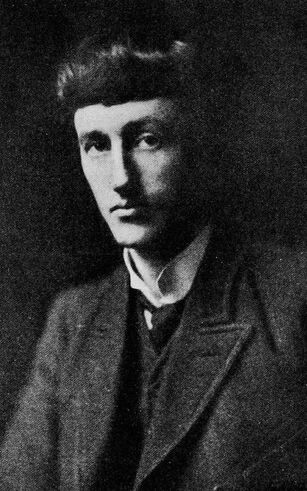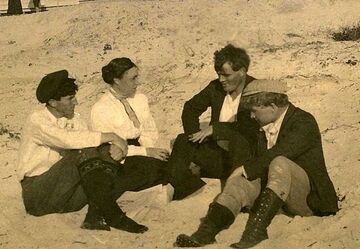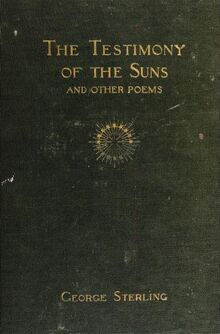
George Sterling (1869-1926) from The Testimony of the Suns, and other poems, 1903. Courtesy Internet Archive.
George Sterling (December 1, 1869 - November 17, 1926) was an American poet, who during his lifetime was celebrated in northern California as a great American poet, though never gaining comparable fame in the rest of the United States.
Life[]
Sterling was born in Sag Harbor, Long Island, New York, the eldest of 9 children. His father was Dr. George A. Sterling, a physician. His mother Mary was a member of the Havens family, prominent in Sag Harbor and the Shelter Island area.
His father was determined to make a priest of a son, and George was selected. For 2 years he attended St. Charles College in Maryland, where he was instructed in English by John Bannister Tabb, then an unpublished poet.
Sterling's uncle, Frank C. Havens, went to San Francisco in the late 19th century and established himself as a prominent lawyer and real estate developer. Sterling eventually followed him to the Bay Area in 1890 and worked for 18 years as a real estate broker.

(l to r) George Sterling, Mary Austin, Jack London, & James Hooper in Carmel, California. Courtesy Wikimedia Commons.
Sterling became a significant figure in bohemian literary circles in northern California in the early 20th century. In the development of the artists' colony in Carmel, he was mentored by a much older Ambrose Bierce, and became close friends with Jack London and Clark Ashton Smith, and later a mentor to Robinson Jeffers. His association with Charles Rollo Peters may have led to his move to Carmel. The hamlet had been discovered by Charles Warren Stoddard and others, but Sterling made the place world famous. His aunt Missus Havens purchased a home for him in Carmel Pines where he lived for 6 years.
Sterling, posing with caricatures of himself at the Bohemian Grove, 1907
Kevin Starr (1973) wrote:
- "The uncrowned King of Bohemia (so his friends called him), Sterling had been at the center of every artistic circle in the San Francisco Bay Area. Celebrated as the embodiment of the local artistic scene, though forgotten today, Sterling had in his lifetime been linked with the immortals, his name carved on the walls of the Panama-Pacific International Exposition next to the great poets of the past."
Joseph Noel (1940) says that Sterling's poem, "A Wine of Wizardry,"[1] has "been classed by many authorities as the greatest poem ever written by an American author."
According to Noel, Sterling sent the final draft of A Wine of Wizardry to the normally acerbic and critical Ambrose Bierce. Bierce said "If I could find a flaw in it, I should quickly call your attention to it... It takes the breath away."
Sterling joined the Bohemian Club and acted in their theatrical productions each summer at the Bohemian Grove.[2] For the main Grove play in 1907, the club presented The Triumph of Bohemia, Sterling's verse drama depicting the battle between the "Spirit of Bohemia" and Mammon for the souls of the grove's woodmen.[3] Sterling also supplied lyrics for the musical numbers at the 1918 Grove play.[2]
Bierce, who acclaimed Sterling's poem "The Testimony of the Suns in his "Prattle" column in the San Francisco Examiner, arranged for the publication of "A Wine of Wizardry" in the September 1907 Cosmopolitan, which afforded Sterling some national notice. In an introduction to the poem, Bierce wrote "Whatever length of days may be according to this magazine, it is not likely to do anything more notable in literature than it accomplished in this issue by the publication of Mr. George Sterling's poem, 'A Wine of Wizardry.'" Bierce wrote to Sterling, "I hardly know how to speak of it. No poem in English of equal length has so bewildering a wealth of imagination. Not Spencer himself has flung such a profusion of jewels into so small a casket".
George Sterling posed for an illustration by Adelaide Hanscom Leeson which appeared in a printing of the Rubaiyat of Omar Khayyam.
Sterling fell into drinking and his wife departed. Noel, a personal acquaintance, says that when he began the poem, Sterling "was persuaded that there was another world than that we know. He repeated this to me so frequently that it became a trifle tiresome. Of the means he employed to get a glimpse of that other world, I am not so sure." He observes that "many before Sterling had used narcotics to this end;" that "George, a doctor's son, had always had access to whatever drugs he fancied;" says that Sterling's wife said "that George had purloined a great quantity of opium from his brother Wickham," and speaks of "internal evidence in the poem" in which "Sterling writes his Fancy awakened with a 'brow caressed by poppybloom.'" Despite all this, Noel makes a point of saying "there is no direct evidence that Sterling used narcotics."
Sterling also wrote a children's book, The Saga of the Pony Express.
Despite such famous mentors as Bierce and Ina Coolbrith, and his long association with London, Sterling himself never became well known outside California.
Sterling carried a vial of cyanide for many years. When asked about it he said "A prison becomes a home if you have the key".[4] Iin November 1926, Sterling used it at his residence at the Bohemian Club. Kevin Starr wrote that "When George Sterling's corpse was discovered in his room at the Bohemian Club ... the golden age of San Francisco's bohemia had definitely come to a miserable end."
Writing[]
Sterling's poetry is both visionary and mystical, but he also wrote ribald quatrains that were often unprintable and left unpublished. His style reflects the Romantic charm of such poets as Shelley, Keats and Poe, and he provided guidance and encouragement to the similarly-inclined Clark Ashton Smith at the beginning of Smith's own career.
Sterling's most famous line was delivered to the city of San Francisco, "the cool, grey city of love!".[5]
Recognition[]
- Sterling Road in Berkeley, California is named for him.
- A stone bench was dedicated to Sterling on June 25th, 1926 at the crest of Hyde Street on Russian Hill in San Francisco.
- He is depicted twice in novels by Jack London: as Russ Brissenden in the autobiographical Martin Eden (1909) and as Mark Hall in The Valley of the Moon (1913).
Publications[]
Poetry[]
- The Testimony of the Suns, and other poems. San Francisco: W.E. Wood, 1903; San Francisco: Book Club of California / John Henry Nash, 1927.
- A Wine of Wizardry, and other poems. San Francisco: A.M. Robertson, 1909.
- The House of Orchids, and other poems. San Francisco: A.M. Robertson, 1911.
- Beyond the Breakers, and other poems. San Francisco: A.M. Robertson, 1914.
- Ode on the Opening of the Panama-Pacific International Exposition, San Francisco, February, 1915. San Franciso: A.M. Robertson, 1915.
- The Evanescent City (with photos by Francis Joseph Bruguiere). San Francisco: A.M. Robertson, 1915.
- The Caged Eagle, and other poems. San Francisco: A.M. Robertson, 1916.
- Yosemite: An ode. San Francisco: A.M. Robertson, 1916.
- The Binding of the Beast, and other war verse. San Francisco: A.M. Robertson, 1917.
- Thirty-five Sonnets. San Francisco: Book Club of California, 1917.
- Lilith: A dramatic poem. San Francisco: A.M. Robertson, 1919.
- Rosamund: A dramatic poem. San Francisco: A.M. Robertson, 1920.
- Sails and Mirage, and other poems. San Francisco: A.M. Robertson, 1921.
- Selected Poems. New York: Holt, 1923.
- Sonnets to Craig. Long Beach, CA: Upton Sinclair, 1928; New York: A. & C. Boni, 1928.
- Poems to Vera. New York: Oxford University Press, 1938.
- After Sunset. San Francisco: J. Howell, 1939.
Plays[]
- The Triumpfh of Bohemia: A forest play. San Francisco: Bohemian Club, 1907.
- Truth. Chicago: Bookfellows, 1923; New York: AMS Press, 1970.
Non-fiction[]
- Robinson Jeffers: The man and the artist. New York: Boni & Liveright, 1926.
Edited[]
- Continent's End: An anthology of contemporary California poets. San Francisco: Book Club of California / John Henry Nash, 1925.
Letters[]
- Give a Man a Boat He Can Sail: Letters (edited by James Henry). Detroit: Harlo, 1980.
- From Baltimore to Bohemia: Letters of H.L. Mencken and George Sterling (with H.L. Mencken; edited by S.T. Joshi & Robert Sterling). Madison, NJ: Fairleigh Dickinson University Press / London & Cranbury, NJ: Associated University Presses, 2001.
- Dear Master: Letters of George Sterling to Ambrose Beirce, 1900-1921. San Francisco: Book Club of California, 2002.
Except where noted, bibliographical information courtesy WorldCat.[6]
See also[]

As It Was in the Beginning (Poetry Audiobook) by George Sterling

The Siren's Song Poetry Audiobook by George Sterling

The Cool, Grey City of Love San Francisco by George Sterling
References[]
- Benediktsson, Thomas E. (1980). George Sterling. Boston: Twayne Publishers. ISBN 0-8057-7313-4.
- Cusatis, John (2006). "George Sterling." Greenwood Encyclopedia of American Poets and Poetry, Volume 5, Westport, CT: Greenwood Publishers, 1530-1531.
- Joshi, S. T. (2008). “George Sterling: Prophet of the Suns,” chapter 1 in Emperors of Dreams: Some notes on weird poetry. Sydney: P’rea Press. ISBN 978-0-9804625-3-1 (pbk) and ISBN 978-0-9804625-4-8 (hbk).
- Noel, Joseph (1940). Footloose in Arcadia. New York: Carrick and Evans.
- Parry, Albert, "Lovely Chaos in Carmel and Taos", chapter 20 of Garretts & Pretenders: A history of bohemianism in America, 1933; republished in 1960 and 2005, Cosimo, Inc. ISBN 159605090X
- Starr, Kevin (1973). Americans and the California Dream 1850-1915. Oxford University Press. 1986 reprint: ISBN 0-19-504233-6
Fonds[]
- Guide to the Collection of George Sterling Papers at the Bancroft Library
Notes[]
- ↑ A Wine of Wizardry at www.idiom.com
- ↑ 2.0 2.1 Mencken, Henry Louis; Sterling, George; Joshi, S.T. From Baltimore to Bohemia: the letters of H.L. Mencken and George Sterling, Fairleigh Dickinson Univ Press, 2001, p. 252. ISBN 0838638694
- ↑ Weir, David. Decadent culture in the United States: art and literature against the American grain, 1890-1926, SUNY Press, 2007, p. 144. ISBN 0791472779
- ↑ The Documentary "The Gospel According to Philip K. Dick"
- ↑ The Cool, Grey City of Love, by George Sterling at alangullette.com
- ↑ Search results = au:George Sterling, WorldCat, OCLC Online Computer Library Center Inc. Web, Apr. 15, 2014.
External links[]
- Poems
- "Autumn"
- George Sterling at the Poetry Foundation
- "A Wine of Wizardry" by George Sterling at idiom.com
- Sterling inPoetry: A magazine of verse, 1912-1922:]] "A Legend of the Dove," "At the Grand Cañon," "Kindred"
- Sterling in The New Poetry: An anthology: "A Legend of the Dove," "Kindred," "Omnia Exuent in Mysterium," "The Last Days"
- Poems by George Sterling at the Poetry Archive (14 poems)
- George Sterling profile & poems at My Poetic Side
- George Sterling at Poetry Nook (25 poems)
- George Sterling (1869-1926): A collection of Sterling's poems; notes on memorial glade in San Francisco
- Poems at GeorgeSterling.org.
- George Sterling at PoemHunter (127 poems)
- Audio/video
- 5 short radio episodes from Sterling's poems at California Legacy Project
- George Sterling poems at YouTube
- Books
- George Sterling at Project Gutenberg
- [https://archive.org/search.php?query=creator%3A%22Sterling%2C+George%2C+1869-1926% Sterling, George (1869-1926) at Internet Archive
- George Sterling at Amazon.com
- About
- A George Sterling Page: A brief biography of Sterling
- George Sterling, Poet: A page by the poet's grand niece
- George Sterling: Poet and friend by Clark Ashton Smith
- George Sterling Official website: Collected works, image gallery, bibliography, and critical articles
| This page uses Creative Commons Licensed content from Wikipedia. (view article). (view authors). |
|
